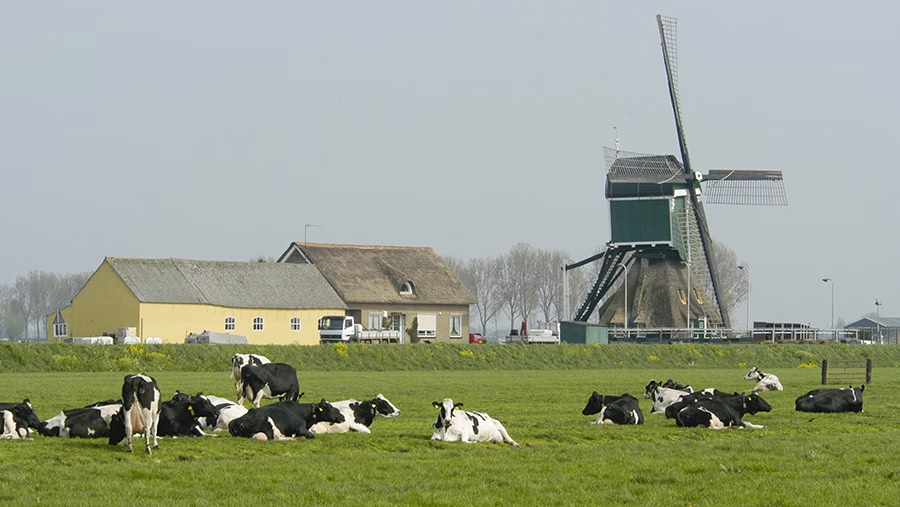Fonterra profits soar, EU butter prices rocket, and US markets defy forecasts—what’s next for global dairy?
EXECUTIVE SUMMARY: Fonterra’s FY25 interim results reveal an 8% net profit surge to NZ $729M and a 16% operating profit jump, driven by premium products and efficiency gains. EU butter prices exploded 33.5% YoY to €7,548/MT, while SMP stagnated, reflecting a structural shift toward fat-rich products. US Class III futures rallied to $18.53/cwt, defying USDA’s bearish outlook, as block cheese prices rebounded. Production disparities widened: New Zealand’s milk solids grew 3.7% YTD, while the EU faced declines. Strategic plays include capitalizing on the $1,106 GDT butter-AMF spread, hedging futures, and adopting precision breeding.
KEY TAKEAWAYS
- Fonterra’s Profit Powerhouse: NZ $729M net profit and NZ $1.07B operating profit, fueled by digital overhauls and premium protein investments.
- EU Butter’s Golden Run: Prices soared 33.5% YoY (€7,548/MT), outpacing SMP (€2,443/MT) and driving cheese gains (Cheddar: +19.4%, Mozzarella: +16.7%).
- US Markets Defy USDA: Class III futures hit $18.53/cwt (vs. USDA’s $17.95/cwt) as cream multiples crash below 1.00, signaling summer demand spikes.
- Production Divide: Oceania thrives (NZ: +3.7% YTD) while Europe struggles (Netherlands: -2.1% YTD).
- Strategic Action: Target butterfat premiums, hedge Class III futures, and adopt sexed semen (+18% GB adoption) for herd optimization.

The global dairy industry is buzzing with high-stakes action. Fonterra’s profits are surging, EU butter prices are breaking records, and US markets are defying USDA forecasts. Whether you’re chasing butterfat premiums or hedging Class III futures, this report cuts through the noise to deliver the intel you need to stay ahead of the herd.
Fonterra Posts Record Profits: NZ $729M Net Profit
“We’re locking in value at every turn” — Miles Hurrell, Fonterra CEO
New Zealand’s dairy powerhouse Fonterra delivered stellar FY25 interim results:
- Net profit surged 8% to NZ $729 million (Fonterra Interim Report)
- Operating profit jumped 16% to NZ $1.07 billion
- Farmgate milk price midpoint held steady at NZ $10.00/kgMS
Farmers benefit from a narrowed milk price forecast range (NZ $9.70-$10.30/kgMS) and a 3.6% season-to-date production surge, driven by improved pasture conditions.
Fonterra continues to invest heavily in strategic expansions:
- NZ $75M high-value protein plant at Studholme
- NZ $150M UHT cream line at Edendale
- NZ $130M digital overhaul, aiming for a 12% supply chain efficiency boost
Fonterra Financial Firepower
| Metric | FY25 Interim Result | YoY Change |
| Net Profit | NZ $729M | +8% |
| Operating Profit | NZ $1.07B | +16% |
| Milk Price Midpoint | NZ $10.00/kgMS | Held |
| CAPEX Commitments | NZ $130M | New |
“This isn’t just profit—it’s war chest building,” says a Wellington analyst tracking Fonterra’s NZ $500M digital overhaul.
EU Butter Prices Explode: Up 31% Year-Over-Year
“SMP prices are stuck in neutral while butter drives the entire complex” — Jan De Vries, Amsterdam Dairy Trader
European butter prices continue their meteoric rise, hitting €7,548/MT (+33.5% YoY) (EC Market Reports). French butter leads the charge at €7,590/MT, while Dutch and German butter trail closely at €7,530-7,525/MT.
Cheese markets are also surging:
- Cheddar Curd climbs to €4,858/MT (+19.4%)
- Mozzarella rockets €618/MT higher than last year
EU Price Volcano
| Product | Current Price | YoY Change | Price Leader |
| Butter | €7,548/MT | +33.5% | France (+€250) |
| SMP | €2,443/MT | +3.0% | Germany (€2,460) |
| Young Gouda | €4,465/MT | +12.0% | Netherlands |
| Mozzarella | €4,310/MT | +16.7% | Italy |
Production Wars: Oceania Gains vs EU Struggles
“Oceania’s efficiency is leaving Europe in the dust” — Rabobank Global Dairy Analyst
New Zealand continues to dominate with robust production growth:
- February milk solids up 1.5% YoY (NZ Dairy Stats)
- Season-to-date production rockets 3.7% higher
Meanwhile, Europe faces production headwinds: Dutch milk collections fell 2.6% YoY in February (adjusted for leap year), while SMP prices stalled at €2,443/MT as buyers balk at thin inventories (Rabobank 2025 Outlook).
In the US, herd dynamics are shifting as sexed semen adoption reshapes genetics and milk solids concentration reaches record highs.
Global Production Showdown
| Region | Feb Milk Solids Growth | Season Growth YTD | Herd Strategy |
| New Zealand | +1.5% | +3.7% | Pasture-first optimization |
| Australia | Flat | +0.8% | Focus on fat % (4.37% avg) |
| EU (Netherlands) | -0.2% | -2.1% | Slaughter rates up 4% |
| USA | +1.1% | +0.9% | Sexed semen adoption +18% |
US Markets Defy USDA Gloom: Class III Futures Rally
“The market smells a squeeze” — Chicago Futures Trader
While the USDA slashes its 2025 forecasts—cutting the all-milk price by to .60/cwt—traders remain bullish on Class III futures:
- CME Class III futures hit $18.53/cwt, exceeding USDA’s Q2 projection ($17.95/cwt).
- Block cheese prices rallied to $1.6950/lb, defying oversupply concerns.
Butter stocks are up 26%, but cream multiples have crashed below 1.00—a signal that summer demand spikes could be imminent.
Strategic Plays for Smart Operators
Butterfat Bonanza
Capitalize on the $1,106 spread between GDT butter and AMF, and focus on increasing milk fat percentages for higher returns.
Hedge the Gap
Lock in Class III futures above USDA forecasts and leverage programs like Fonterra’s Fixed Milk Price for stability.
Track the Tech
Adopt precision breeding techniques as sexed semen reshapes herd genetics across GB herds (+18%).
Fonterra’s Strategic Investments Signal Long-Term Gains
“Digital overhauls will squeeze 12% more efficiency from our supply chain” — Fonterra Board Statement
Fonterra is doubling down on innovation with major projects aimed at boosting profitability and sustainability:
Fonterra’s Strategic Investments
| Project | Location | Investment | Timeline | Expected Impact |
| High-Value Protein Plant | Studholme | NZ $75M | 2026 | +15% protein yield |
| UHT Cream Line | Edendale | NZ $150M | Q3 2025 | 40M additional liters/year |
| Digital Overhaul | Nationwide | NZ $130M | 2025-2030 | 12% supply chain efficiency gain |
| Decarbonization Push | Clandeboye | NZ $45M | 2027 | 9% emissions reduction |
Is the EU Butter Bubble About to Burst?
“With butter stocks rising 26% and cream multiples crashing, the EU’s golden run may face headwinds. — Amsterdam Trader
The Bottom Line
This is no time for complacency! With Fonterra printing money, EU churns maxed out, and US markets defying expectations, dairy producers who act now will be first in line when the market turns.
Strap in—the second half of 2025 could make or break operations. Those who read these tea leaves today will be tomorrow’s leaders.
Learn more
- Fonterra’s Digital Overhaul: How NZ Farmers Can Capitalize on Tech Advancements
- The Butter Bubble: Why EU Price Peaks Could Signal a Market Shift
- US Dairy Policy Changes: What the 2025 Federal Order Revisions Mean for Farmers
 Join the Revolution!
Join the Revolution!
Join over 30,000 successful dairy professionals who rely on Bullvine Daily for their competitive edge. Delivered directly to your inbox each week, our exclusive industry insights help you make smarter decisions while saving precious hours every week. Never miss critical updates on milk production trends, breakthrough technologies, and profit-boosting strategies that top producers are already implementing. Subscribe now to transform your dairy operation’s efficiency and profitability—your future success is just one click away.







 Join the Revolution!
Join the Revolution!







